In This Article
Corrosion Protection
Decking Fasteners
Hidden Deck Fasteners
Structural Connectors View all DECKS & PORCHES Articles
Choosing deck fasteners and hardware, such as joist hangers, used to be pretty straightforward. After 2004, all that changed with the phase out of CCA-treated lumber and the introduction of a new family of wood preservatives for pressure-treated lumber. The two main preservatives used, ACQ (alkaline copper quat) and CA (copper azole), are far more corrosive to steel, aluminum, and galvanized coatings, making selection of hardware and fasteners a more complicated and critical decision.
When fasteners corrode, they contribute to decay in the surrounding wood, further weakening the connection. The failure of a joist hanger or deck ledger connection can have catastrophic results such as a deck collapse.
New Preservatives and Corrosion.The two leading wood preservatives used today, ACQ and CA, are estimated to be two to five times more corrosive to metals and galvanized coatings than the CCA they replaced, based on numerous tests. The increase results from higher concentrations of copper, which is corrosive to steel and other metals, and the removal of chromium and arsenic, which helped suppress corrosion. Formulations with ammonia-based carriers (used for better penetration in heartwood species such as Douglas fir) are even more corrosive than standard formulas.
Most treated yellow-pine, the dominant treated wood in the eastern and central U.S., now uses “micronized” formula that is thought to be less corrosive than standard ACQ and CA.
Other than the treatment chemicals use, several other factors affect the rate of corrosion, but moisture is the most important. Since water is necessary for corrosion to occur, the wetter the environment and the closer the fasteners are to moist ground, the faster metals will corrode. Salt air and spray in coastal and environments significantly speed up corrosion.
So a joist hanger on a seaside deck is going to rust away much faster than the same piece of hardware on a bone-dry deck in Arizona.
The concentration of preservatives in the wood also has a big effect. A 6×6 rated for ground contact has a higher level of chemicals, and therefore greater corrosion potential, than a 2×8 or decking plank rated for above-ground use. Check the label, typically stapled to one end of a stick of lumber if you’re unsure.
CORROSION PROTECTION
These problems have spawned the development of a wide array of coated and heavily galvanized hardware rated for contact with ACQ- and CA-treated wood. For any hardware exposed to these chemicals the standard G-90 galvanized steel fasteners and connectors have been upgraded to more expensive protective finishes: either G-185 galvanized, proprietary polymer-coatings, or stainless-steel – the best and most expensive option. Widely used aluminum flashings should also not be used in contact with today’s pressure-treated lumber.
Hot-Dipped Galvanized. When using lumber treated with ACQ or copper azole, use hot-dipped galvanized fasteners that meet ASTM A153 (or the newer ASTM F2329, or connectors that meet ASTM A653. These have a minimum coating of 1.85 ounces of zinc per square foot of metal surface (G185) an are sometimes marketed as “double-hot-dipped” and other tradenames such as ZMax and HDG for Simpson, and Triple-Zinc for USP.
Remember, however, that all galvanized coatings are sacrificial. They are designed to slowly wear away to protect the underlying steel. Once the coating is gone, the steel will fail quickly. Manufacturers will not guarantee any specific lifespan because there are too many variables. So in a very wet environment, coastal areas, or other harsh exposure, the added cost of stainless steel is a worthwhile investment.
Also galvanized fasteners may stain redwood and cedar, a concern if you are using these species.
Polymer-Coatings Manufacturers have introduced a wide variety of coated screws and connectors, such as joist hangers, for use with today’s more corrosive wood treatments. Most common are polymer coatings over a thin electrogalvanized finish. The coatings protect the metal by keeping water and dissolved copper away. The more layers of coating the better, but since you won’t be able to determine this, make sure you use coated fasteners listed for code compliance.
Because the coatings are thinner and more slippery, they make much better decking screws. Also these coatings can be applied to tempered steel, not an option for hot-dipped galvanized fasteners which would undo the tempering. The tempered steel and slippery surface has also made coated screws, such as LedgerLOKs, popular for structural connections in place of traditional lag bolts.
Polymer coatings can also be used for steel connectors with large surface areas, such as joist hangers and other connectors widely used on decks. Only one manufacturer, USP offers polymer-coated GoldCoat connectors. Simpson offers polymer coatings on screws and bolts, but, not on connectors.
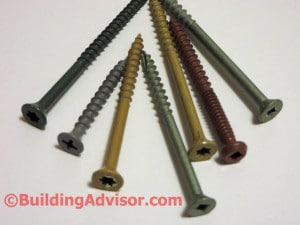
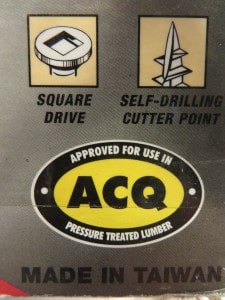
There are now dozens of fasteners on the market with an endless variety of proprietary coatings. Most say something like “ACQ compatible” on the packaging. But up until recently, buyers had little else to go on other than the manufacturer’s in-house testing.
In 2009, the ICC published a testing standard, AC257, by which coated fasteners can gain code acceptance via a ICC-ES Evaluation Report. The test shows equivalence to the galvanized coating standard ASTM A153. Evaluation reports are widely used by manufacturers of alternative products to demonstrate their compliance with building code standards.
Look for an ICC ER or ESR number on the product label (or the company’s website), which you can look up at the ICC Evaluation Service website. You may also see the words ICC or IRC Code Compliant, AC257-Approved, or similar language on the product label.
Stainless Steel. No doubt about it – stainless steel is expensive – averaging from three to eight times the cost of triple zinc, but it’s the only option where success is guaranteed under harsh conditions. Both types 304 and 316 stainless steel have been tested for use with ACQ and CA. Type 304 is suitable for all above-ground applications. Type 316 is recommended in areas subject to salt or salt water.
Stainless steel is the best choice near fresh or salt water, in any damp location due, or in areas subject to salt-water spray or deicing salts. In addition, Simpson, a leading manufacturer of framing hardware, recommends stainless steel for other corrosion risks including exposure to “fire retardants, fumes, fertilizers, soil, industrial zones, and acid rain.” Stainless steel is also recommended for tropical hardwoods, which tend to cause staining with galvanized or coated nails.
Because of the high cost, you might consider stainless steel just for critical joints such as bearing beams and safety railings. In marginal situations, where conditions are uncertain, you should consider upgrading to stainless for the peace of mind. It may add a few hundred dollars to the cost of a project, but a relatively small percentage overall.
Aluminum. Do not use aluminum fasteners, connectors, or flashings in contact with pressure-treated wood. The copper-based waterborne preservatives will cause corrosion and premature failure
Caution: Don’t mix and match metals. Never use stainless steel in contact with galvanized steel, as the galvanized coating will quickly corrode. Where fasteners such as nails, bolts, or lags are in contact with metal connectors, use the same metal for both.
Membranes Barriers. If a joist hanger or other connector never touches the treated wood, then copper ions should not attack the galvanized coating (although a small amount of water dripping from above could still be a concern). Simpson has tested this concept using Grace Vycor Deck Protector. With all the usual caveats like “Test results may or may not have a relation to actual service life,” they found that the barrier method worked well with their ZMAX and HDG coated connectors. With the membrane in place, ACQ and CA-B treated wood was less corrosive than the CCA-treated wood used before 2004.
DECKING FASTENERS
Decking Screws. Few professionals still install decking with nails, as screws do a much better job. They keep the decking snug and don’t pop up like nails often do after a few years. For treated wood, use a screw that meets ASTM A153, or has an ICC Evaluation Service (ES) listing under AC257. Most coated decking screws claim on the package to be “compatible” or “approved” for use with ACQ or “all treated woods.” Don’t believe it without the required test report.
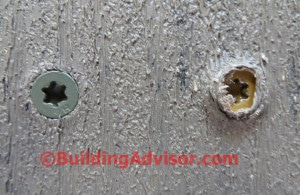
Specialized decking screws are available for hardwood, composite decking, and capped composites in matching colors. Many specialized decking screws have cutting nubs under the head for self-countersinking in wood. Composite decking screws have special thread designs and concave “pancake” heads that leave a crisp hole in the decking surface without the typical pucker of excess material (mushrooming) around the screw head.
Galvanized nails and screws can sometimes cause discoloration with redwood, cedar, and tropical hardwoods, so stainless steel is a safer choice with these materials. Aluminum screws are also an option for redwood or cedar, but not with pressure-treated wood.
Many decking screws come with square-drive and star-drive (Torx drive) heads, in addition to the more familiar Philipps head. I prefer Torx, but like square head as well. Both allow higher torque driving without stripping the head for a cleaner job. Also, they are much easier to remove if necessary. Once you use them, you’ll never go back to Phillips head screws.
Spacing the Decking. When securing the decking, it is important to leave adequate spacing between the boards for water to drain. Plan for about an 1/8-inch gap (the diameter of an 8d nail) between boards after the decking has dried to its equilibrium moisture content. If the decking is installed wet, as is common with pressure-treated material, it is best to install the boards tight, letting gaps form as the wood dries.
When installing kiln-dried stock, use a 16d common nail as a spacer to leave enough space for the boards to swell slightly and still leave an adequate drainage space. For wood that has partially air-dried, it is a judgment call. If in doubt, it is best to err on the side of leaving a little extra space for the wood to swell when wet.
For plastic and composite decking, follow the manufacturer’s instructions. Synthetic decking products are very stable in width, but expand and contract lengthwise with changes in temperature. Solid wood decking does just the opposite. It shrinks and swells in width, but changes little in length with changes in moisture content.
Protecting the Joists. In decking applications subject to wet conditions or the buildup of leaves and tree debris, it is best to protect the tops of the joists from moisture. This can be achieved by laying strips of felt paper or self-adhesive membrane (one approved for UV exposure) over the tops of each joist prior to laying the decking boards. A proprietary product for this application, Vycor Deck Protector™, is available from Grace Construction Products. This is the same material tested by hardware manufacturer Simpson for use as a barrier between pressure-treated joists and metal hardware to reduce corrosion.
HIDDEN DECK FASTENERS
Over time, face-nailed or face-screwed deck boards may loosen. Fasteners may stain the wood decking, or lead to splitting and water penetration. Seasonal swelling and shrinking of the wood lifts nail heads, and even screws to a lesser extent, above the surface. Particularly with high-end decking materials, such as tropical hardwoods and premium composites, more customers are opting for hidden fastening systems.
A wide variety of systems are now available and most manufacturers of composites now offer their own private-labelled fastening system. Some require that you use their system or lose warranty support and others publish a list of compatible systems. In some cases the location of the slot or density of the material requires a certain type of fastener.
Because of the variability of composite and plastic decking products, it’s always a good idea to follow their recommendations for both surface and hidden fasteners.
In general, hidden fasteners allow more movement in the decking than face-screwing, which can lead to squeaking or slight movement. For that reason, some manufacturers recommend also using adhesive on wood decking.
While allowing movement can be helpful with composites, which expand and contract along their length, it can be a challenge with wood decking which shrinks and swells in width. For that reason, they should only be used with woods that are dimensionally stable – true of most tropical hardwoods.
Wood decking that is installed when it is much wetter or dryer than it will be in service can also be a problem for hidden fasteners. Shrinking wood can pull out of prongs or release fasteners from slots. Swelling wood can cause cupping or eliminate gaps necessary for some fasteners to function properly.
One concern with hidden fasteners is that they do not provide the same level of horizontal bracing as face-screwing (similar to plywood on floor joists). So on large or high decks, additional solid blocking between joists or cross bracing may be advisable.
For most installers, the biggest concern with hidden deck fasteners is whether they are strong enough to resist the tendency of deck boards to cup, warp, or move. For that reason, they are best used with premium, dimensionally stable decking products. Tropical hardwoods and composite decking are the best candidates for hidden fasteners. However, even Ipe will overcome some hidden fasteners, especially in climates with large seasonal moisture swings.
Finally hidden fasteners are a lot more expensive and slower to install than face screws – especially if you are using a biscuit jointer to cut slots. Some install with special tools that speed up installation, but this is not something you would buy for a deck or two.
Types of Hidden Deck Fasteners. There are three main types of hidden deck fasteners with a number of variations. Some are better for hardwood; some for composites. Only a few would be recommended for standard yellow pine, which is probably best face-screwed. Before choosing a system, it’s a good idea to read reviews and, if possible, see a deck that has had the fasteners in place for a few years.
Many of these were invented by individual deck builders with a bright idea and later bought by larger fastener companies.
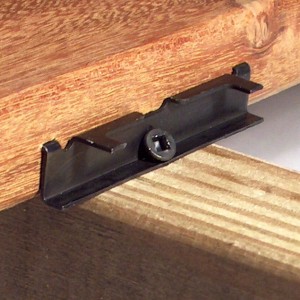
Pronged-Clips. These have one or more horizontal prongs that are hammered into the adjoining board and screw down to the joist. Clips with a proven track record include the Tiger Claw, Simpson’s Deck-Tie, the Dec-Klip, and the Tebo, a unique three-prong fastener that installs with a special tool and no uses no additional nails or screws. Most of these clips are visible to some extent, but still much less apparent than surface screws. Using black or color-matched fasteners helps make them disappear.
Some require proprietary tools to install or offer this option. For example, Fastenmaster sells a pneumatic installer for their Tiger Claw fasteners.
Two pronged clips, the Tiger Claw TC-G and Deckmaster Deck Clip, are designed for use in slotted decking, similar to the biscuit clips described below.
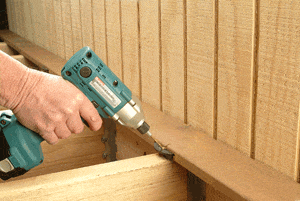
Biscuit Clips. Similar to pronged clips, these fit into biscuit slots or pre-milled grooves. Most people who have installed these with a biscuit jointer opt for pre-milled boards the next time around. One system, the Eb-Ty was one of the original hidden fastening products and now comes in several flavors for different types of decking. The Ipe Clip and Ipe Clip Extreme are similar products designed for use with tropical hardwoods.
Locking Clips. These are clever fasteners that attach to one board, usually from the bottom, and then lock in the next board as it slips into place. They screw to the top or side of the joist and either screw from the bottom – or into the bottom of the decking plank before it is flipped over and installed. Some have come and gone. Two that have established a track record are Invisi-Fast and Hidden Link.
Face-Screw and Plug. Widely used with ipe and other tropical hardwoods, a similar system is gaining popularity with plastic and capped composites. The Cortex Hidden Fastening system uses a special torx (star) drive bit that drives the screw and countersinks the head in one step with no pre-drilling required. Plugs color-matched to many of the leading plastic and composite decking products are tapped into place and nearly invisible.
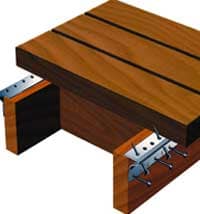
Track Systems. These are the least visible “hidden” systems and probably have the greatest holding power. They require a deck high enough that you can comfortably screw into the decking from the bottom – with a second person standing on top to position and flatten the decking in place. It’s possible, but awkard, to work from above by reaching down and screwing upward. The two main offerings, both with long track records, are the Deckmaster Fastening System and Shadoe Track. Neither is fast, but provide solid attachment with minimal visibility.
STRUCTURAL FASTENERS AND CONNECTORS
At minimum, all structural hardware for decks should be hot-dipped galvanized steel. With treated lumber, use G-185 galvanized or polymer-coated steel. For marine or wet environments, ground-contact, or exposure to salts or other corrosive chemicals, stainless steel is your best choice.
Galvanized fasteners for use with treated lumber should meet ASTM A153 (or the newer ASTM F2329). Metal connectors, such as joist hangers, should meet ASTM A635. Alternative coated fasteners and connectors should have a ICC-ES listing based on AC257 showing compliance with the building code. You can find the ES or ESR test number on the manufacturer’s website or at the ICC website.
If you are buying in bulk, ask the vendor for the product’s technical specs.. At a bare minimum, choose galvanized hardware with a rough, dull gray finish, indicating hot-dipped treatment rather than electrogalvanizing. And don’t mix metals such as stainless steel and galvanized. Use bolts, washers, and nuts, and connectors of the same metal to avoid causing galvanic action.
At connections carrying structural loads, such as deck ledgers or railing posts, use through-bolts or lag screws. Through-bolts are stronger and should be used where possible. For the most critical connections on a deck, such as where ledgers attach to the house or to railing posts, use 1/2-inch bolts or lag screws. Or use new specialty ledger screws, such as LedgerLOKs, which can be substituted for lags, simplifying installations with no loss of strength.
Bolts. Where both sides of the joint are accessible, bolts offer the strongest connections. Drill pilot holes 1/32 to 1/16 in. larger than the diameter of the bolt so it will slide through easily. After drilling, saturate the hole with preservative (min. 1% naphthenate). Use large washers under both the head and nut. Retighten after the first year, since the wood may have shrunk.
Lags. For lags, drill a full-diameter pilot hole for the unthreaded portion and a smaller hole (65% to 75% of the lag’s diameter) for the threaded portion. For example, a ½-in. lag would get a 5/16-in. pilot hole for the threaded portion; a 3/8-in. lag would get a ¼-in. pilot hole. After drilling, saturate the pilot hole with wood preservative.
It is also important that at least half the length of the lag is threaded into solid wood. For example, driving a 5-in. lag through a 4×4 post into a 2x joist will produce a weak connection with only 1½ inches of anchoring. Instead, the lag screw should go through the 2x first, and be threaded into the thicker 4×4. Use a large washer under the head, and retighten after the first year in case materials have shrunk.
Ledger Screws. For many deck builders, LedgerLOKs, GRK RSS, and similar polymer-coated, tempered screws have largely replaced galvanized lag bolts for fastening ledgers, railing posts, and other structural connections.
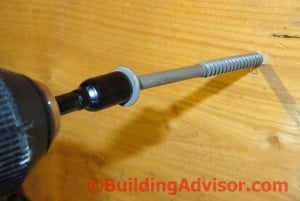
Tempering, not an option with hot-dipped galvanized, has allowed manufacturers to engineer long thin screws with shear strengths and holding power equivalent to comparable lag screws. With the slippery polymer coating, these also drive much faster than a lag bolt with no pre-drilling required in most cases.
Coated structural screws have been in the market long enough to win over many converts, myself included. You’ll find many uses for these and other coated, tempered screws. The larger manufacturers have done the required testing to establish code compliance for strength and corrosion resistance with treated wood (via Evaluation Reports).
If you’re using them for structural connections, make sure they have the required code listings. If you’re not sure, look for an ICC ESR or ER number on the label or company website. Using this number, you can easily look up the code approvals at the ICC Evaluation Service website.
Joist Hangers and Steel Connectors. At a minimum, use hot-dipped galvanized hardware. With pressure-treated wood, hot-dipped galvanized steel should conform to ASTM A153 (for fasteners) or ASTM A653, G185 (for connectors). Stainless steel offers the best protection. Type 304 or higher stainless steel is recommended for very wet environments such as poolside decks, or Type 316 for exposure to salt or saltwater. Also, do not mix metals: Use stainless-steel fasteners with stainless-steel connectors and galvanized fasteners with galvanized connectors to prevent corrosion from galvanic reaction between the metals.
Jim Blair says
Effectiveness of Galvanized Coatings Applied On-Site
I live on the NC coast. I have 8×8 posts with galvanized bolts supporting a double 8×32 decks with staircase.
Only 7 years old and and rust because of ocean and treated lumber.
Is there a coating I can put into the hole for the bolt that can protect it? I plan to coat each bolt with cold galvanized 93% zinc before putting it back in.
buildingadvisor says
In a coastal climate, I recommend stainless steel for critical pieces of steel hardware that are in contact with pressure-treated lumber or exposed to its runoff — for example, a standoff bracket at the bottom of a pressure-treated post. Physical barriers placed between the lumber and the steel can be helpful.
For less critical hardware — or items that are easy to monitor and replace, I often use hot-dipped galvanized fasteners and connectors — preferably rated to G185. Screws and bolts with proprietary coatings rated for use with pressure-treated lumber also appear to hold up well.
Salt spray plus pressure-treated lumber is worst-case scenario for steel corrosion, so if you want a connection to last, go for the best metal you can afford.
I have never used field-applied “cold galvanized” coatings, but don’t see how these can compete with hot-dip galvanization. This involves a number of chemical cleaning steps followed by immersion in molten zinc at over 800 degrees F, causing a metallurgical reaction that bonds the zinc to the steel.
I have tried rust-proofing paints, along with a three-part rust treatments on auto rust. Nothing has lasted much more than 1-2 years, which is what I would expect from field-applied zinc coatings or other field-applied rust treatments in your climate.
Edward R. Bolt says
I am about to embark on a footbridge decking project and am planning to use Trex 1 x 6 product. I like the idea of the slotted boards with concealed fasteners, but also want to save a few dollars. Does use of a standard solid section with direct screwing (exposed fasteners) guarantee some leakage (and swelling) around the exposed fasteners eventually?
buildingadvisor says
Directly screwing the decking boards is fine. In fact, you generally get a stronger connection with screws than with a concealed fastener system.
Just make sure to use non-corrosive decking screws. It’s best to use screws specifically made for composite decking as these will allow the screw heads to set flush rather than leaving a pucker or “mushroom” of excess material. Composite decking screws also have special thread designs engineered to reduce the need for predrilling and to pull the decking tight to the framing. Most use a reverse-thread design.
There are several different brands of composite decking screws with somewhat different characteristics. Although all screw manufacturers claim that you do not need to pre-drill, you may find pre-drilling necessary with some types of screws and decking materials. It’s best to experiment before buying a large quantity of screws as they are pretty expensive.
TrapEase are the most widely available composite decking screw, and work well, but you may need to predrill for best results, especially with some of the denser composites. SplitStop Composite Screws are an excellent choice but hard to find in some areas. GRK Composite Trim Head Screws are another good option with a similar design. For extreme conditions (and big budgets) Starborne makes the HeadCote line of stainless-steel composite decking screws, available color-matched to many decking products.
It’s best to contact the decking manufacturer to find out which screws they recommend for their product.
In general, you don’t want to drive composite decking screws too fast or sink them too deep into the decking. They should be just flush with the surface. Water leakage at the screws should not be a problem, but swelling can occur if the wrong type of screw is used or it is set too deep. You need to especially careful with capped composites as you are drilling through the capstock that keeps moisture out of the core of the boards. With capped composites, you may be better off with a hidden fastener system.
Drew says
What’s Best Screw Type for Decking?
Just looking for some advice on the best deck screw head type. I am going to replace my deck screws so I can countersink them. I have to do this so I can sand and refinish my deck. Currently the screws are standard #2 philips head, but they strip out too easily. I see hex head and square head available and am wondering which is best. I live at 9ooo feet elevation in Colorado and the deck has East/South East exposure. I just want to be able to shovel snow off my deck without constantly hitting raised screws. I plan on buying stainless steel and am looking for a screw head type that doesn’t easily strip out,
buildingadvisor says
The best all-around screw head for decks and other structural uses is the “Torx”, also known as a star-head screw (at left, in photo). Many coated and stainless-steel screws are now available with this type of head. After using them, you’ll never want to use a phillips-head again. They never strip, even if the driver is a little out of alignment with the screw.
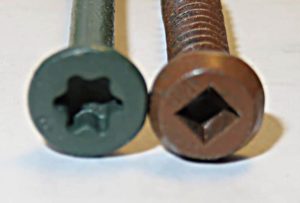
The only downside is that star-head screws come in lot of different sizes – make sure you use the exact match for the screw. The correct driver number will be indicated on the box of screws. A driver that is one-size too small will usually work, but may strip out the driver or screw head.
Square-drive screws are the next best in terms of resisting stripping. But they don’t come close to Torx head for overall performance.
Best of luck with your new deck!
BuyWoodScrews says
Use Stainless-Steel Screws
Very informative. Most of the professionals we work with recommend and prefer deck screws for decking as they are the most reliable fastener. The best are stainless-steel deck screws. They are durable and are corrosion and rust-free.
Richard says
Powder-Coated Hangers & Treated Lumber
Will treated lumber affect powder coat hangers?
buildingadvisor says
Powder coating is more durable than ordinary paint as it is applied dry with an electrostatic charge and baked on creating a smooth, even coating. It is moderately resistant to peeling, chipping, and corrosion. However, the level of durability is a function of the thickness of the coating – thick on something like an auto bumper and thin on something like a joist hanger.
If you’ve ever bought powder-coated lawn chairs, you know what they look like in a few years – pretty rusty. That coating is similar to what you’ll get on a joist hanger. On hangers, powder coating is considered decorative is not expected to resist corrosion. So anything that will lead to corrosion in the underlying steel – salt air, air pollution, pressure-treatment chemicals, will shorten the life of the powder coating as well.
Connector manufacturer Simpson Stong-Tie considers its powder coating a decorative finish with low level of corrosion resistance, similar to their gray paint finish. However, you can special-order any Simpson hanger with a powder coat. If you specify Z-Max hangers, which are rated for exterior use with treated lumber, then you can expect good performance.
The treated lumber should not harm the powder coating. If you are in coastal or urban area with higher corrosion potential, however, you may want to add a “barrier membrane” (such as Vycor Deck Protector) to prevent direct contact between the pressure-treated lumber and the steel connector.
Related links: Corrosion protection of fasteners and connectors Simpson Strong-Tie coatings and finishes